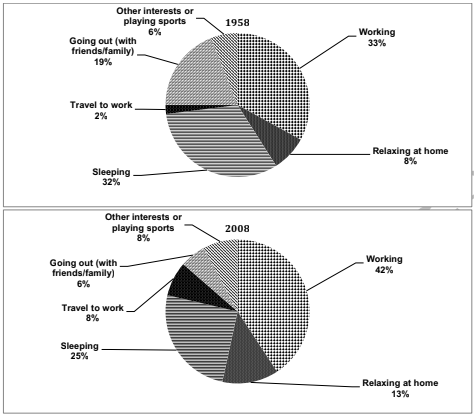[Anna N] Writing Practice Test 1003647
Task 1
You should spend about 20 minutes on this task.
The pie charts below show the percentage of time working adults spent on different activities in a particular country in 1958 and 2008. Summarise the information by selecting and reporting the main features and make comparisons where relevant
You should write at least 150 words.

The chart demonstrates the distribution of hours spent by employees between 1958 and 2008. In general, a significant difference is noted in the time allotted for their personal and social activities.
Over five decades, the working hours of the average labor force have increased steadily, from 33% in 1958 to 42% in 2008. A similar pattern is also seen in other aspects such as time for relaxation at home and other leisure activities, which increased by 5% and 2% respectively. A noteworthy observation is seen in the employees' time for travel. Despite the advances in transportation and road infrastructure, the average time spent by an employee to go to work rose from 2% in 1958 to 8% in 2008.
On the other hand, a decline in the average time for socialization and sleeping was observed between the two time periods. Workers were noted to spend less time with their families and friends with a significant drop of 13%. Hours allotted for quality sleep also decreased by 10%.
To summarize, there has been considerable changes in how the average employee spends his time over the past decades.
Task 2
You should spend about 40 minutes on this task.
Nowadays, not enough students choose science subjects in university in many countries. What are the reasons for this problem? What are the effects on society?
You should write at least 250 words.
Throughout history, mankind has achieved several mind-blowing breakthroughs that have led to our present-day advancement. We owe such gratitude to dedicated men and women of science and research. We are in constant need for these kinds of talents if we want to continue achieving new milestones. However, despite this urgent calling for new minds to train, science courses in universities do not meet the admission level required to replenish the existing workforce needed in various scientific and research fields. We will explore what are the possible causes behind this issue and what can be the potential effect on our present society and future generations.
A dwindling interest for discovery and learning is one possible cause for the decrease in admission. Technology has made it possible for students to know anything and everything in a flash. The mysteries of science no longer amaze them since they can simply access the information they need about a certain topic. In addition, the processes involved in science courses require time and effort. Students have grown impatient and would rather go for courses that may give them better financial growth opportunities at a shorter period of time.
As the percentage of potential committed scientists, doctors, and researchers falls in the coming years, we may expect a plateau in our future breakthroughs. Though we may have the technology to aid us in new discoveries, technology alone cannot compensate for human input. We cannot totally disregard the weight of human contribution in scientific progress. We are still in need of talented and dedicated professionals for us to evolve beyond our present limits and knowledge.
Overall, the present downtrend in science course admissions may be traced from a decreasing interest and impatience for the subject matter among today's students. If this decline continues, our society may face a significant delay in potential future growth.
Community’s feedback
Sorry! We couldn't find any contents.
Leaderboard:
| # | User | Score | Time | |
|---|---|---|---|---|
| Subid Basaula |  | 7.0 | 59:58 | |
| Yuki Arai |  | 6.5 | 58:09 | |
| Gayane Aramyan |  | 6.0 | 49:19 |



